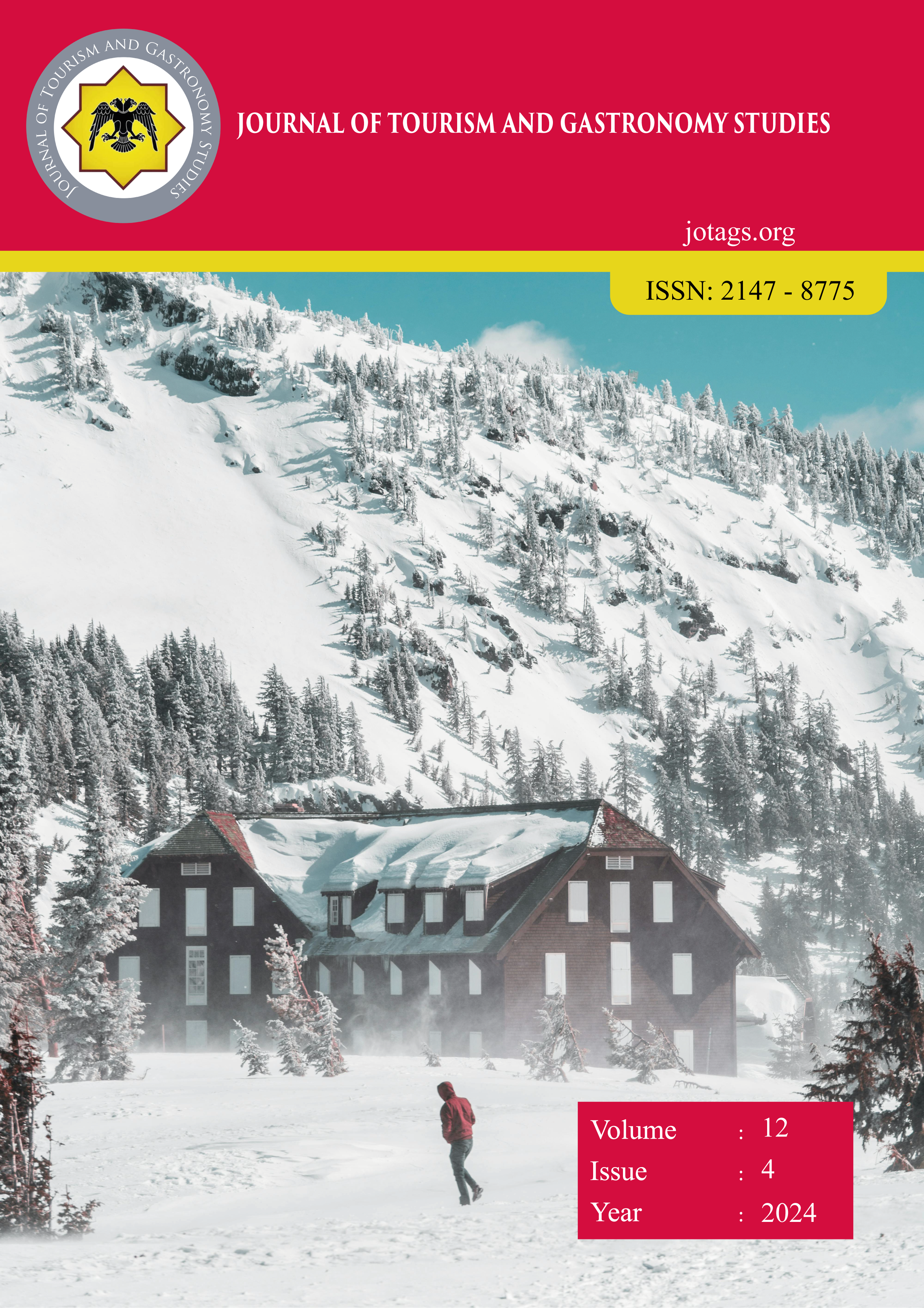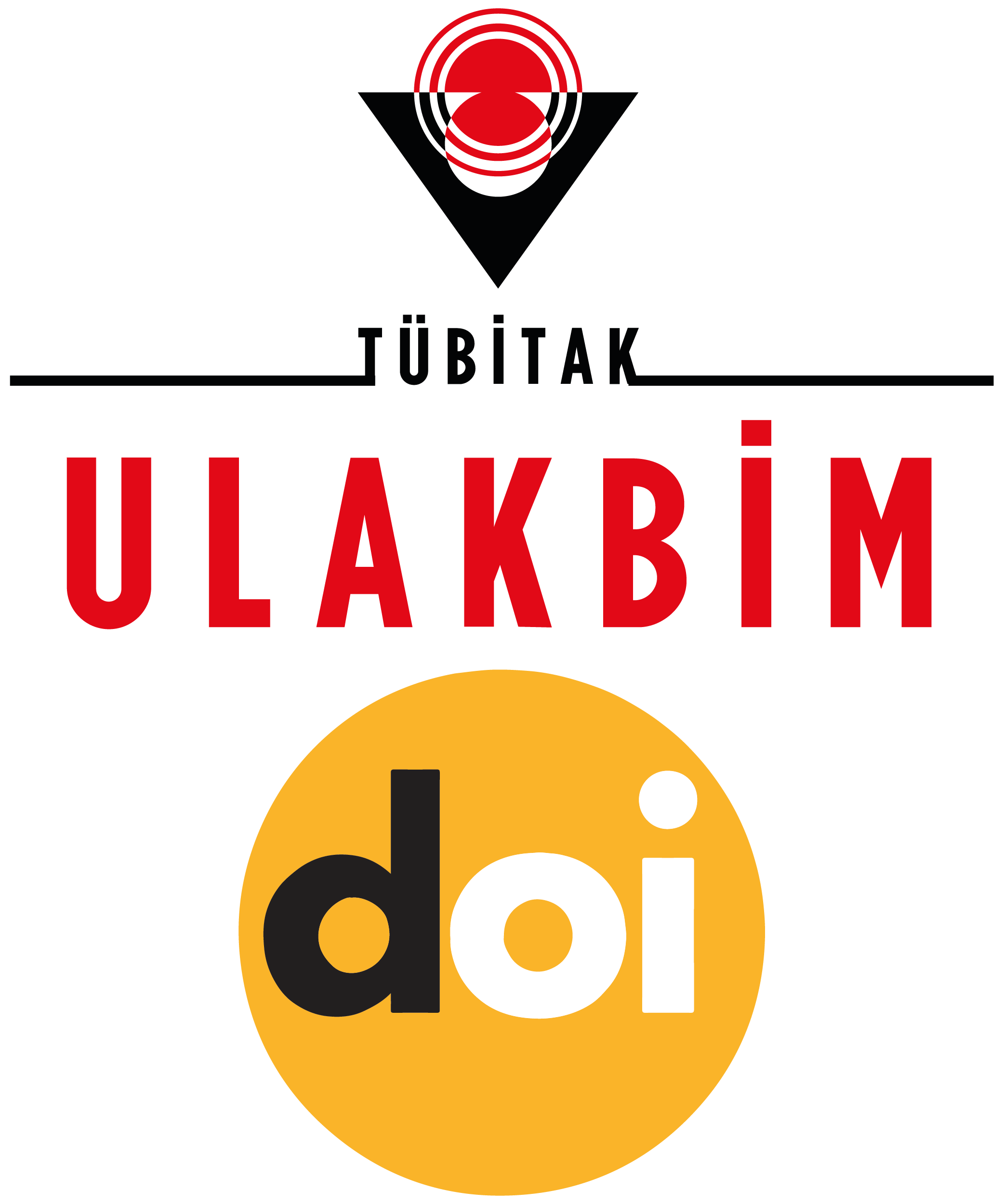A New Concept in Gastronomy: Cinegastronomy
DOI:
https://doi.org/10.21325/jotags.2024.1493Keywords:
Cinegastronomy, Cinema, Gastronomy, Semiotics in cinema, Food cultureAbstract
In this study, we aimed to define the theoretical and conceptual framework of cinegastronomy, a new concept we seek to introduce in the field of gastronomy. To achieve this, we conducted an electronic brainstorming session with 55 cinema professionals using the AnswerGarden® program. We analyzed the collected data using content analysis to create themes, and employed the nominal prioritization technique to prioritize these themes. As a result, we divided the concept of cinegastronomy into three main themes and twelve sub-themes: (1) gastronomic symbols, (2) the meeting of cinema and gastronomy, and (3) the reflection of humans and food in cinema. The twelve sub-themes are ranked in order of importance, with the top three being: (1) a narrative and representation tool within film; (2) innovative and engaging; and (3) the combined use of gastronomy and signs in cinema. Overall, we define cinegastronomy as the expression of gastronomic perceptions and, beyond that, realistic or metaphorical indicators through cinematographic techniques.
References
Abramson, J. (2017). French food on film: beyond gastronomy in La Noire de…, Chocolat, and La Graine et le mulet. Contemporary French Civilization, 42(3-4), 259-278.
Ağan, C., & Doğan, M. (2022). Lezzet ve lezzetin bilimi: Mutfak şeflerinin lezzet algıları üzerine bir araştırma. Safran Kültür ve Turizm Araştırmaları Dergisi, 5(2), 199-219.
Aksoy, M., & Çetin, K. (2018). Çatalhöyük mutfak yapıları ve araç-gereçlerinin 21. yüzyıl mutfak kültürüne yansımaları. Journal of Tourism & Gastronomy Studies, 6(1), 125-141.
Aksoy, M., İflazoğlu, N., & Canbolat, C. (2016). Avrupa aşçılık tarihi: Antik Yunan'dan Sanayi Devrimi'ne. Journal of Recreation and Tourism Research, 3(1), 54-62.
Al-Samarraie, H., & Hurmuzan, S. (2018). A review of brainstorming techniques in higher education. Thinking Skills and Creativity, 27, 78-91.
Amorim, M. M. A., Santiago, M. C., & Ramos, N. (2020). Representações sociais da alimentação retratadas no cinema. Revista Pasajes, (10), 59-74.
Aulet, S., Fernandes, C., & Timothy, D. J. (2021). Food and religion: Tourism perspectives. In The Routledge Handbook of Religious and Spiritual Tourism (pp. 411-427). United Kingdom, London: Routledge.
Aydın, B. O., Duğan, Ö., & Gürbüz, S. (2018). Gastronomi TV programı kaynaklı turizm: Gaziantep örneği. Manas Sosyal Araştırmalar Dergisi, 6(5), 33-48.
Naderifar, M., Goli, H., & Ghaljaie, F. (2017). Snowball sampling: A purposeful method of sampling in qualitative research. Strides in Development of Medical Education, 14(3).
Baron, C. (2006). Dinner and a movie: Analyzing food and film. Food, Culture & Society, 9(1), 93-117.
Bigliardi, S. (2020). A gastronomic anti-seminar: Marco Ferreri’s La grande abbuffata and the philosophy of food. Food, Culture & Society, 23(3), 399-415.
Bingör, B. (2016). Küreselleşmenin Yemek Kültürüne Etkileri. İstanbul Üniversitesi Sosyal Bilimler Enstitüsü Yüksek Lisans Tezi. İstanbul.
Bosio, A. (2019). Food places through the visual media: Building gastronomic. Food: Expressions and Impressions, 57. Leiden, Netherlands: Brill.
Coëgnarts, M. (2017). Cinema and the embodied mind: metaphor and simulation in understanding meaning in films. Palgrave Communications, 3(1), 1-15.
Corvo, P. (2016). Food Culture, Consumption and Society. United Kingdom, London: Palgrave Macmillan
Çakır, M. U., Şengül, S., & Parmaksızoğlu, E. (2020). Sinema perdesinde gastronomi görüntüsü: Yemeğin sosyolojik yansımaları. Journal of Tourism and Gastronomy Studies. 8(4), 3173-3191
Çam, O. & Çelik, C. (2024). Görgü ve Nezaket Kuralları ile Gastronomi. Umay, 2(3), 23-36.
Çaycı, A. E., & Aktaş, C. (2018). Dijitalden tatmak: yemeğin “yeni” gastro mekânlardaki seyirlik gösterisinin kültürel yansımaları. Trt Akademi, 3(6), 710-727.
Çinay, H. H., & Sezerel, H. (2020). Ferzan Özpetek filmlerinde gösterge olarak yemek: Mine vaganti/serseri mayınlar üzerine bir inceleme (Food as a sign in Ferzan Özpeteks’s Films: An analysis on Mine Vaganti). Journal of Tourism & Gastronomy Studies, 8(1), 111-136.
Çinay, H. H., & Sezerel, H. (2021). Fatih Akın filmlerinde yemek ve sofranın temsili (The representation of food and table in Fatih Akın Films). Journal of Tourism & Gastronomy Studies, 9(4), 2670-2690.
Daştan, N., & Atnur, G. (2023). Mcdonaldlaşma yaklaşımı ve erzurum’da su böreğinin fast-foodlaşma süreci (McDonaldization approach and fast-food process layered pastry in Erzurum). Journal of Tourism & Gastronomy Studies, 11(1), 328-346.
de Bem Machado, A., & Richter, M. F. (2021). Integrative review: Relations between sustainable consumption and conscious consumer. Internet Latent Corpus Journal, 11(1), 6-22.
Demirgül, F. (2018). Çadırdan saraya Türk mutfağı. Uluslararası Türk Dünyası Turizm Araştırmaları Dergisi, 3(1), 105-125.
Dennis, A. R., & Williams, M. L. (2003). Electronic Brainstorming: Theory, Research and Future Directions, in: Group Creativity, Paulus, P.(Ed.), Oxford University Press, Oxford.
Doğan, M. (2021). Gıda Felsefesine Giriş. In Gıda Felsefesi. Ankara, Türkiye, Nobel Akademik Yayıncılık.
Doğan, M. (2023a). Kur’an-ı Kerim’de yer alan gastronomi unsurlarının Kütüb-i Sitte bağlamında değerlendirilmesi. Sanat ve Tasarım Dergisi, 3(2), 148-185.
Doğan, M. (2023b). Gastronomi Mühendisliği. Ankara, Türkiye, Nobel Akademik Yayıncılık.
Doğan, M., & Özdemir, K. (2022). Investigation of the effect of spice on gastronomy history and culture. İzlek Akademik Dergi, 5(2), 27-41.
Doğan, M., & Sönmez, M. (2022). Sömürge dönemi köleliğin yemek kültürüne etkilerinin araştırılması. Review of Tourism Administration Journal.
Doğan, M., & Vatandost, E. G. (2023). Gıda çalışmalarında yeni yaklaşım: Gıda egemenliği. Ocak: Türk Mutfak Kültürü Araştırmaları Dergisi (Turkic Culinary Culture Research).
Doğan, M., & Yaşlıca, Z. S. (2022). Evaluation of gastronomic objects in renaissance painting. International Journal of Gastronomy and Food Science, 30, 100606.
Doğan, M., & Yazıcı, S. (2023). A study on the perceived organisational business continuity of foodservice executives. International Journal of Business Continuity and Risk Management, 13(3), 302-322.
Drzał-Sierocka, A. (2015). Celluloid Flavours. A Brief History of Food in Film. Łódzkie Studia Etnograficzne, 54(1), 52-70.
Dunat, S. (2022). Time metaphors in film: Understanding the representation of time in Cinema. Film-Philosophy, 26(1), 1-25.
Durmelat, S. (2015). Tasting displacement: Couscous and culinary citizenship in Maghrebi-French diasporic cinema. Food and Foodways, 23(1-2), 104-126.
Dursun, F., & Güzeleller, C. O. (2023). Yemek bağlamında kültürlerarası etkileşim: Göç, yemek ve kimlik ilişkisi üzerine kavramsal bir çalışma (Interaction in the context of food: A conceptual study on the relationship between migration, food, and identity). Journal of Tourism & Gastronomy Studies, 11(4), 2674-2689.
Elsaesser, T. (2017). Film history as media archaeology: Tracking digital cinema. Netherlands, Amsterdam: Amsterdam University Press.
Enriquez, J. P., & Archila-Godinez, J. C. (2022). Social and cultural influences on food choices: A review. Critical Reviews in Food Science and Nutrition, 62(13), 3698-3704.
Epstein, R. L. (2001). Re-Ordering the Scene: The Hollywood restaurant and american culinary culture, 1947–1963. Journal for the Study of Food and Society, 5(1), 9-29.
Fernandes, K. F., & Jose, A. (2021). A pinch of salt in hotel or kitchen: Reading recipes as narrative tools in contemporary malayalam cinema. Kala Sarova, 24(2),507-513.
Forgas-Serra, S., Fernández, J. M., & i Cerdan, L. M. (2018). The influence of culinary movies as a popular culture tourism phenomenon in shoot destinations. In The Routledge Handbook of Popular Culture and Tourism (pp. 439-449). United Kingdom, London: Routledge.
Fuchs, C. (2008). The implications of new information and communication technologies for sustainability. Environment, Development and Sustainability, 10, 291-309.
Godara, K. C., & Dev, N. (2021). The growth of culinary and food related content on visual and social media. International Journal of Research in Engineering, Science and Management, 4(12), 61-65.
Graf, K., & Mescoli, E. (2020). Special issue introduction: From nature to culture? Lévi-Strauss’ legacy and the study of contemporary foodways. Food, Culture & Society, 23(4), 465-471.
Greenlee, D. (2018). Peirce’s concept of sign (Vol. 5). Berlin, Germany: Walter de Gruyter GmbH & Co KG.
Griswold, W. (2012). Cultures and Societies in A Changing World. USA, California: Sage Publishing.
Guptill, A. E., Copelton, D. A., & Lucal, B. (2022). Food & Society: Principles and Paradoxes. USA, Hoboken, New Jersey: John Wiley & Sons.
Hamilton, D. L. (2022). Cognitive representations of persons. In Social Cognition (pp. 135-160). United Kingdom, London: Routledge.
Harvey, N., & Holmes, C. A. (2012). Nominal group technique: An effective method for obtaining group consensus. International Journal of Nursing Practice, 18(2), 188-194.
Isin, P. M. (2025). Bountiful empire: a history of ottoman cuisine. United Kingdom, London: Reaktion Books.
Islakoğlu, Ü. G. (2024). Dışarda yeme teorisi bağlamında the menu (2022) filmi üzerine bir inceleme (An analysis on the menu (2022) in the context of the theory of eating out). Journal of Tourism & Gastronomy Studies, 12(2), 1016-1036.
Kanburoğlu, Ö. (2017). İstanbul’da film sektörünün durum analizi ve sektörün geleceği projesi analiz raporu. İstanbul Kalkınma Ajansı, https://www.istka.org.tr/media/67270/%C4%B0stanbul-da-film-sekt%C3%B6r%C3%BCn%C3%BCn-durum-analizi-ve-sekt%C3%B6r%C3%BCn-gelece%C4%9Fi-projesi-analiz-raporu.pdf
Karaman, N. (2023). Orta Asya’dan Cumhuriyet dönemi Türkiye’sine: tarihsel süreç içerisinde Türk mutfak kültürünün gelişimi. Balıkesir Üniversitesi Sosyal Bilimler Enstitüsü Dergisi, 26(49-1), 595-610.
Keller, J. R. (2014). Food, Film and Culture: A Genre Study. USA, Jefferson, North Carolina: McFarland.
Kleinheksel, A. J., Rockich-Winston, N., Tawfik, H., & Wyatt, T. R. (2020). Demystifying content analysis. American Journal of Pharmaceutical Education, 84(1), 7113.
Klinger, B. (2006). Beyond The Multiplex: Cinema, New Technologies, and The Home. USA, Berkeley: University of California Press.
Kosinova, M. I. (2022). Problems and Prospects for the Development of Digital Distribution in the Film Industry. In Digital Technologies and Institutions for Sustainable Development (pp. 229-234). Switzerland, Cham: Springer International Publishing.
Kozak, M. (2021). Bilimsel Araştırma: Tasarım, Yazım ve Yayım Teknikleri. Ankara: Detay Yayıncılık.
Köksal, F. N., & İnatçı, Ü. (2023). Visual Representation of Food in Italian Cinema. In Routledge Handbook of Descriptive Rhetorical Studies and World Languages (pp. 380-390). United Kingdom, London: Routledge.
Kubrak, T. (2020). Impact of films: Changes in young people’s attitudes after watching a movie. Behavioral Sciences, 10(5), 86.
Linden, S. (2015). Film and gastro tourism: An overview of recent trends. Book of Abstracts of The International Conference on Tourism (ICOT2015): From Tourism Policy into Practice: Issues and Challenges in Engaging Policy Makers and End Users London 24-27 June 2015. (p. 221).
Lindenfeld, L., & Parasecoli, F. (2016). Feasting Our Eyes: Food Films and Cultural Identity in The United States. USA, New York: Columbia University Press.
Lindenfeld, L., & Parasecoli, F. (2023). Food and the Senses in Film. Media Studies Volume 100, 195.
Lorusso, A. M. (2015). Interpretation and Culture: Umberto Eco’s Theory. In Cultural Semiotics: For a Cultural Perspective in Semiotics (pp. 117-158). USA, New York: Palgrave Macmillan US.
Mahar, C. (Ed.). (2010). Cuisine and Symbolic Capital: Food in Film and Literature. United Kingdom, Newcastle: Cambridge Scholars Publishing.
Mangiapane, F. (2024). Wine as represented in contemporary cinema. A semiotic review. Signata. Annales des sémiotiques/Annals of Semiotics, (15).
Meral, P. S. (2024). Yeme-içmenin göstergebilimsel serüveni. Yemek ve İçmenin İletişimi,37, Türkiye, İstanbul: Efe Akademi Yayınları.
Mol, A. (2021). Eating in Theory. USA, Durham, North Carolina: Duke University Press.
Montanari, M., & Brombert, B. A. (2015). Medieval Tastes: Food, Cooking, and The Table. USA, New York: Columbia University Press.
Monteiro, I. F., Matias, E. M., & Consoni, F. (2023). Délicieux: Um Banquete Para Além Das Telas: Délicieux: A Banquet That Goes Beyond The Screen. Revista Turismo Estudos e Práticas-RTEP/UERN, 12(1).
Murray, R. L., & Heumann, J. K. (2012). Contemporary eco-food films: The documentary tradition. Studies in Documentary Film, 6(1), 43-59.
O’Mahony, P. (2023). Critical theory, Peirce and the theory of society. European Journal of Social Theory, 26(2), 258-281.
Okumuş, M. S. (2022). The effects of Covid-19 pandemic on audience practices in cinema, television, and OTT platforms. İstanbul Ticaret Üniversitesi Sosyal Bilimler Dergisi, 21(43), 133-147.
Özer, E. Z., & Şalkamoğlu, B. (2024). Sinema filmlerinde gastronomi semiyolojisi (Gastronomy semiology in moiıon picture film). Journal of Tourism & Gastronomy Studies, 12(2), 1329-1346.
Pilcher, J. M. (2012). Cultural histories of food. In The Oxford handbook of food history (pp. 41-60). USA, New York: Oxford University Press.
Pilcher, J. M. (2023). Food in World History. United Kingdom, London: Routledge.
Reddy, G., & van Dam, R. M. (2020). Food, culture, and identity in multicultural societies: Insights from Singapore. Appetite, 149, 104633.
Roldán-García, A. (2020). Haptic for Gourmets: Cinema, Gastronomy, and Strategic Exoticism in Eat Drink Man Woman and Tortilla Soup. In (In) digestion in Literature and Film (pp. 32-50). United Kingdom, London: Routledge.
Rosenstone, R. A. (Ed.). (2020). Revisioning History: Film and The Construction of A New Past. USA, New Jersey: Princeton University Press.
Sali, M. (2023). Hybridization in the Eating Habits of International Students in Türkiye. İstanbul University Journal of Sociology, 43(1), 132-143.
Samancı, Ö. (2020). Osmanlı ve Cumhuriyet dönemlerinde yemek kitapları. Anatolia: Turizm Araştırmaları Dergisi, 31(2), 205-210.
Sırıklı, Ö. G. İ. K., & Kara, H. H. (2024). Yemeğe Dair Tabuların Sosyal Etkileşimdeki Yeri. Yemek ve İçmenin İletişimi, Türkiye, İstanbul: Efe Akademi Yayınları.
Smith, D., Cartwright, M., Dyson, J., & Aitken, L. M. (2024). Use of nominal group technique methods in the virtual setting: A reflective account and recommendations for practice. Australian Critical Care, 37(1), 158-165.
Stano, S. (2015). Semiotics of Food (pp. 647-671). Springer Netherlands.
Stano, S. (2024). Nurturing meaning: Food, myth, and signification. Signata. Annales des sémiotiques/Annals of Semiotics, (15).
Surace, B. (2022). New generations and axiologies of food in cinema and new media. Food for Thought: Nourishment, Culture, Meaning, 131-144.
Şahin, E. Ö. (2023). Küreselleşme ve mutfak: Uluslararası mutfaklar üzerine bibliyometrik bir inceleme (Globalization and cuisine: A bibliometric study on international cuisines). Journal of Tourism & Gastronomy Studies, 11(4), 3358-3372.
Şengül, S., & Çakır, M. U. (2023). The use of food in cinema as a soft power instrument. In Global Perspectives on Soft Power Management in Business (pp. 425-442). IGI Global.
Тасболатұлы, Ә., Хеджази, C., & Исмагамбетова, З. Н. (2023). Symbolic Concepts of Culture and the Problem of Language of Cinema. Қарағанды университетінің хабаршысы Тарих. Философия сериясы, 110(2), 375-381.
Tatlı, E., & Doğan, R. (2020). İnanç turizminde kutsal yiyecekler: İçerik analizi örneği. Uluslararası Sosyal Bilimler Akademik Araştırmalar Dergisi, 4(1), 88-97.
Üner, E. H. (2023). Mutfakta Rönesans: Yeni Çağ avrupa mutfak kültürü (Renaissance in the Kitchen: The Early Modern European Culinary Culture). Journal of Tourism & Gastronomy Studies, 11(2), 1230-1242.
Vardar, Ş., & Çağlayan, E. (2023). Türk kültüründe renk olgusu ve turkuaz rengin Türk resim sanatındaki yeri. Safran Kültür ve Turizm Araştırmaları Dergisi, 6(3), 501-514.
Weiss, R. (2022). Adam and eve: Reflections on a relationship. gender, creation myths and their reception in western civilization: Prometheus, Pandora, Adam and Eve, 97.
Wocke, B. (2016). Dining as a ‘Limit Experience’: Jouissance and Gastronomic Pleasure as Cinematographic and Cultural Phenomena. In Food, Media and Contemporary Culture: The Edible Image (pp. 220-238). United Kingdom, London: Palgrave Macmillan UK.
Wollen, P. (2019). Signs and Meaning in the Cinema. United Kingdom, London: Bloomsbury Publishing.
Yacavone, D. (2018). Chapter Fourteen. The Anthem Handbook of Screen Theory, 245. United Kingdom, London: Anthem Press.
Yalcin, M. (2023). Türk yemek kültür mirasının coğrafyası, kaynağı ve evreleri. Türk Tarihi Araştırmaları Dergisi, 8(2), 128-142.
Yilmaz, H., & Yüksel, A. (2021). Gastronomy Themed Movies. Journal of Tourism, Leisure and Hospitality, 3(2).
Zimmerman, S. (2009). Food in films: A star is born. Gastronomica, 9(2), 25-34.
Zimmerman, S. (2010). Food in the Movies. USA, Jefferson, North Carolina: McFarland.
Published
How to Cite
Issue
Section
License
Copyright (c) 2024 Journal of Tourism & Gastronomy Studies

This work is licensed under a Creative Commons Attribution-NonCommercial 4.0 International License.








